
Indosylvirana temporalis, commonly known as the bronzed frog or Günther's golden-backed frog, is a species of true frog found in the riparian evergreen forests of the highlands of southwestern Sri Lanka. They are found abundantly on or close to the ground near water. Individuals are not shy and react by jumping only when provoked. They are important prey of many species of snakes, including the vine snake. Some related species found in the Western Ghats of India were formerly included in this species but were separated in a 2014 study.

The fungoid frog or Malabar Hills frog is a colourful frog found on the forest floor and lower vegetation in the Western Ghats in south-western India from Bombay to Kerala. It is very similar to another species with which it overlaps partly in range, Hydrophylax bahuvistara which extends further into parts of central India. Although restricted in range within peninsular India, they are of least conservation concern. Their upper parts vary in colour from brownish-red to bright crimson.
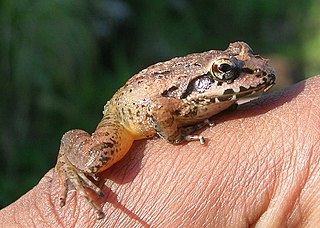
Indirana is a genus of frogs in the family Ranixalidae. These frogs are endemic to the Western Ghats of India. They are sometimes known under the common name Indian frogs, whereas members of their parent family are named "leaping frogs".

Indirana beddomii, Beddome's leaping frog, Beddome's Indian frog, or simply Beddome's frog, is a species of frog found in the Western Ghats. They are usually detected by their long leaps as they flush from the ground when disturbed. The species is named after the naturalist Richard Henry Beddome.

Indirana semipalmata is a species of frog endemic to the Western Ghats region of southern India. They are small frogs, reaching lengths of about 36 mm (1.4 in) from snout to vent. The species breeds during the monsoons, laying their eggs on moist rocks and tree bark. Their tadpoles are terrestrial – hatching, feeding, and undergoing metamorphosis without ever entering any standing bodies of water.
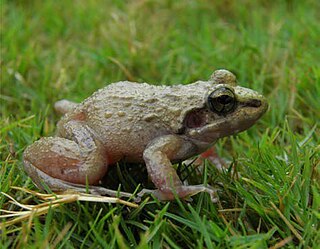
Indirana leithii is a species of frog in the family Ranixalidae. It is endemic to the northern Western Ghats of India. As currently defined, its range is restricted to the states of Maharashtra and southern Gujarat; earlier records elsewhere refer to other species.

Indirana brachytarsus is a species of frog found in the Western Ghats of India. It is locally common terrestrial frog associated with hill streams in wet evergreen and semi-evergreen tropical forests and swamps. It may also be found at forest edges but does not penetrate further to agricultural land. It breeds on wet rocks, and the tadpoles are found on wet rock surfaces next to streams.

Walkerana diplosticta, also known as the spotted leaping frog, Malabar Indian frog, rufous leaf-hopper frog, and Günther's frog, is a species of frog in the family Ranixalidae. It is endemic to the Western Ghats south of the Palghat Gap and only known with certainty from the states of Kerala and Tamil Nadu, India. Localities with confirmed records include the Kalakkad Mundanthurai Tiger Reserve.
Indirana gundia is a species of frog found in the Western Ghats of India. It is only known from its type locality, Kempholey, Karnataka. Indirana gundia is listed among "Top 100 EDGE Amphibians". It represents a family that has been evolving independently in India for almost 50 million years.
Walkerana leptodactyla is a species of frog endemic to the southern Western Ghats in Kerala and Tamil Nadu states of southern India. Precise reports are from Anaimalai hills, Palni hills, Meghamalai, Travancore hills and Agasthyamalai.

Walkerana phrynoderma is a species of frog endemic to the Anaimalai Hills, of the Western Ghats of Kerala and Tamil nadu states in southern India. This species is known from Munnar, Eravikulam National Park, Valparai tea gardens, Anamalai Tiger Reserve, Grass Hills National Park and Palni hills. It is a very rare terrestrial frog species associated with leaf-litter in tropical moist forest. It is threatened by habitat loss caused by subsistence wood collecting. It has the status of one of the "Top 100 Evolutionarily Distinct and Globally Endangered Amphibians."
Indirana tenuilingua is a species of frog that is considered nomen inquirendum. It is only known from the type series, now lost, from its type locality, Kemphole, in the Western Ghats of India. It is sometimes known as Rao's Indian frog or slender-tongued frog.

Nannophrys marmorata, commonly known as Kirtisinghe's rock frog or marbled streamlined frog, is a species of frog endemic to Sri Lanka. It used to be placed in the large frog family Ranidae but a phylogenetic study was undertaken using DNA sequences and it is now included in the family Dicroglossidae. Its natural habitats are tropical moist lowland forests, moist montane forests, rivers and streams. It is threatened by habitat loss.

The Bombay night frog, also known as Abdulali's wrinkled frog, Abdulali's night frog or Humayun's wrinkled frog, is a species of frog in the family Nyctibatrachidae. It is endemic to the Western Ghats of Maharashtra state, India. The species is found near torrential hill streams in tropical moist evergreen and semi-evergreen forests, a habitat that is threatened by habitat loss and pollution. Its name honours Humayun Abdulali, an Indian biologist.
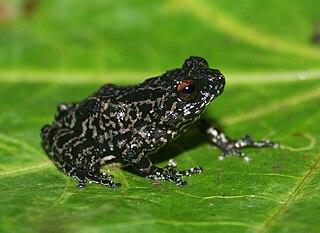
Raorchestes ghatei is a species of shrub frogs from the Western Ghats of Maharashtra.

Ranixalidae is a family of frogs commonly known as the leaping frogs or Indian frogs. They are endemic to central and southern India, specifically in the Western Ghat mountain range. This mountain range encompasses the Indian states of Gujarat, Maharashtra, Goa, Karnataka, Kerala, and Tamil Nadu. Ranixalidae can be found in Maharashtra, Goa, Karnataka, and Kerala. There is a large concentration of them in Goa and Maharashtra, however there are still considerable amounts of species within the southern Indian states of Karnataka and Kerala, where there are other frogs within the Indirana genus.
Walkerana muduga, also known as the Muduga mountain leaping frog or Muduga leaping frog, is a species of frog in the family Ranixalidae. It is endemic to the Western Ghats of India and known from the Elivai Malai range, north of the Palghat Gap in Tamil Nadu. All other known species of Walkerana occur south of the Palghat Gap, and molecular data suggest that Walkerana muduga is deeply divergent from the more southern species. However, there is another, as yet undescribed lineage from north of the Palghat Gap that is known from a single, poorly preserve specimen.
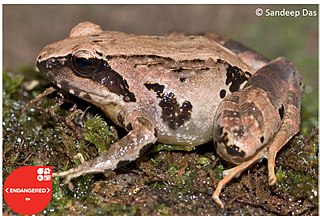
Walkerana is a genus of frogs in the family Ranixalidae. The genus is endemic to the Western Ghats in the states of Kerala and Tamil Nadu, India. It was erected in 2016 to host three species of Indirana that represented a genetically and morphologically distinct clade within the then broadly defined Indirana. Until Walkerana muduga was described in 2020, the genus was only known from the southernmost part of the Western Ghats south of the Palghat Gap.
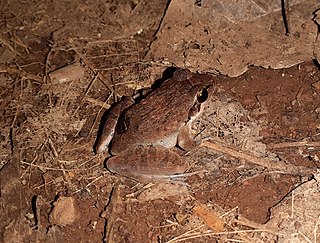
Indirana tysoni, also known by its common name Tyson's leaping frog, is a species from the genus Indirana. The species was originally described in 2016 by Neelesh Dahanukar, Nikhil Modak, Keerthi Krutha, P. O. Nameer, Anand D. Padhye, and Sanjay Molur.
Ghatixalus magnus, the large-sized Ghat tree frog, is a species of frog in the subfamily Rhacophorinae. It is endemic to India, in the southern Western Ghat mountains, between the Palakkad Gap and Shencottah Gap.















